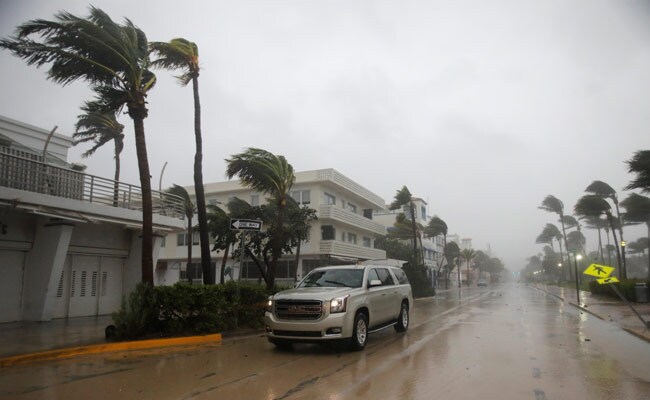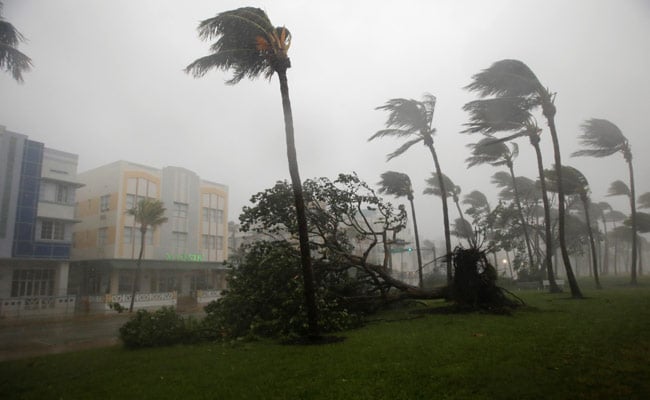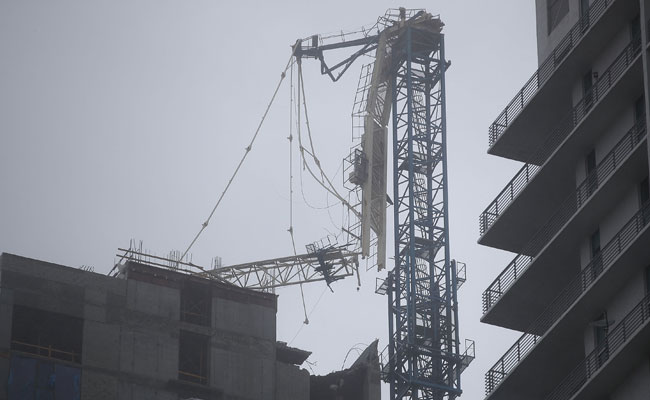
After days of alarming warnings forced millions from their homes and effectively shut down daily life across a wide swath of the Southeastern United States, Irma had earlier Sunday made landfall on the lower Florida Keys before beginning what forecasters say could be a painful journey up the state's western coastline.
The storm breached the Florida coast on Sunday morning, making landfall just after 9 a.m. at Cudjoe Key. After churning through the Keys and on through to Florida's southwestern coast, Irma's second landfall occurred in Marco Island, Florida, at 3:35 p.m. A wind gust of 130 mph was reported by the Marco Island police, according to the National Weather Service.
Irma had already made its presence known across South Florida, causing more than two million power outages and lashing major population centers with driving rain and roof-rattling wind. The danger is only just beginning, forecasters warn, because the storm will grind along Florida's Gulf Coast on Sunday bringing life-threatening storm surge.
"Today is going to be the long day," said Mark DeMaria, deputy acting director of the National Hurricane Center in Miami.

South Florida's large population of elderly residents posed a severe test for the emergency shelters (Reuters)
The hurricane center warned that Irma had created an "imminent danger of life-threatening storm surge flooding along much of the Florida west coast" and said the storm was expected to "move near or over the west coast of the Florida Peninsula through Monday morning."
While Irma's path is now likely to hew to Florida's Gulf Coast, the storm's sheer size and reach - hurricane-force winds extend about 80 miles from the center, and tropical storm winds extend out 220 miles - means that those across the entire state remain imperiled. Regardless of Irma's ultimate track, all of Florida - which is about 360 miles wide across the panhandle, but less than half as wide across much of the middle of the state - most likely will experience damaging winds, rains, flooding and possibly tornadoes.
By Sunday afternoon, even as Irma had shifted to a Category 2 hurricane, it remained a deadly storm with an impact that could be felt across South Florida. The storm was forecast to still remain dangerous as it approaches the densely populated Tampa Bay area, which experts say is woefully ill-equipped to confront a particularly powerful storm. Many people from Florida's eastern coast had sought refuge around Tampa in recent days before the storm's path shifted westward.
Irma spent much of Sunday morning over the Florida Keys, the string of islands off the state's southern coast. The Keys could see up to 25 inches of rainfall and storm surges could wash over the low-lying chain, a popular tourist destination that includes Key West.
"A very dangerous day is unfolding in the Florida Keys and much of West Florida," Michael Brennan, a senior hurricane specialist at the National Hurricane Center, said in an early morning update Sunday. "It certainly could inundate the entire island. That's why everyone in the Keys was urged so strongly to evacuate."
Irma left the Keys by midday Sunday and headed toward the southwest coast of Florida, the National Weather Service reported. As authorities said the storm was closing in on the Naples and Marco Island area, located about 160 miles south of the Tampa region, they warned people there to expect punishing winds and surging water levels.
An empty street as Hurricane Irma arrives at south Florida in Miami Beach (Reuters)
Forecasters said Sunday that water levels in in the Naples and Marco Island region could "rapidly rise in a matter of minutes," which could create life-threatening storm surge in this area. Marco Island officials on Sunday afternoon urged people to leave the ground floors of places and head to the "second or higher floor if possible."
Craig Fugate, the former FEMA administrator, spoke to the same program from Gainesville, Florida, which is just north of the state's center, and warned of the danger posed by the storm surge.
"Water is historically the big killer in these hurricanes," Fugate said. "Death by drowning is what we talk about with storm surge."
Authorities say that more than 6.5 million Floridians - a little more than three in 10 residents statewide - have been ordered to evacuate as Irma's outer bands began to batter the state.
Gov. Rick Scott, R, who has been blunt about the storm's potential, had residents in evacuation zones to leave their homes immediately, noting at a certain point, nobody would be able to come rescue them. Two Florida law enforcement officers were reportedly killed early Sunday in a head-on collision.
"This is a life-threatening situation," Scott said at a news briefing Sunday in Tallahassee, the state's capital. "The storm is here now."
Irma had knocked out power to about 2 million customers by Sunday morning, said Rob Gould, a spokesman for Florida Power and Light. While Gould said the company had restored power to about 320,000 of those customers before noon, leaving 1.7 million without power, the utility's online outage tracker had that number north of 2 million by late Sunday afternoon.
Gould also said there were people impersonating utility employees and then robbing people in their homes at gunpoint, warning customers not to let anyone into their homes without proper identification. At one point, his briefing was interrupted by a brief power outage. "We are not immune to Irma's wrath," he said.

A lone car drives down a road as Hurricane Irma strikes, in Boca Raton, Florida (AFP)
"This is a deadly storm, and our state has never seen anything like it," Scott said.
Officials across the state imposed curfews, ordering people to remain home in places from Miami-Dade and Broward county along the southeast coast to Orange County, home to Orlando in Central Florida. In Miami-Dade, the curfew announced stretched from Sunday evening until Monday morning.
Still, despite tornado warnings and curfews, some decided to venture back into the storm. At Pompano Beach High School, which has been transformed into a shelter, several people decided to leave Saturday night once it looked like the storm's core was shifting away from the eastern part of the state.
"We've got hurricane windows at home and the forecast looks like it's not going to be as bad as they predicted," said Laurie Trinkle, who arrived with relatives shortly after noon on Saturday and decided to leave about 12 hours later. "I think we'll be more comfortable at home as long as the power stays on."
Concerns stretched up the coast, into nearby states where some evacuees sought shelter. About 540,000 people in Georgia and 44,000 in South Carolina also were ordered to evacuate the area by Sunday evening. Airports throughout Florida and in Savannah, Georgia, were closed. Disney World is closed Sunday and Monday, with resort hotels staying open.
Florida authorities said that by Sunday afternoon there were more than 530 shelters open with more than 1116,000 people inside.
Emergencies were declared in Georgia and the Carolinas. President Donald Trump received a briefing on Sunday and spoke with governors of Alabama, Georgia, South Carolina and Tennessee, the White House said.
As storm conditions began to sweep into Miami on Saturday, the bustling city had become a ghost metropolis, with no traffic and few signs of life in most places, though a crowd gathered at Vicky Bakery on Coral Way, the one place for miles that was open.
In downtown Miami, cranes spun like toys, and on Sunday morning one of them collapsed amid pounding winds. The winds were not the only thing to arrive in Miami.
Fire-rescue personnel raced to Little Haiti in response to a call of distress from a woman in labor, according to Miami City Manager Daniel Alfonso, and helped deliver the baby. "Mom and baby are good," he said.
In Estero, on the west coast of Florida, thousands of people wrapped around the massive Germain Arena, which officials opened as a shelter Saturday and has a capacity of 7,000 to 8,000. At least six ambulances responded to people who were overcome in the muggy, 90-degree heat. Troopers, the National Guard and local police sought out people in wheelchairs and moved them to the front of the line, said Lt. Greg Bueno, public information officer for the Florida Highway Patrol.

A crane tower collapses after the winds in Florida
"I feel like I'm in a sardine can, and I don't like it," Dianne said. "My husband said he'll duct-tape me to a chair if I try to open the front door."
Officials at the Collier County emergency operations center in Naples said 15,000 people have filled its shelters, but they are trying to expand space in each location to accommodate more. Demand exceeded expectations as the forecast showed the area probably taking the full force of Irma's impact.
The county said it will be difficult to house everyone who needs or wants to evacuate and urged people who can find shelter with friends or family to go there. Lee County Manager Roger Desjarlais said Saturday afternoon that the county is sheltering 22,000 people. The two counties combined have a population of about 1 million.
Officials also are concerned that wind gusts will send water over the Herbert Hoover Dike that holds back Lake Okeechobee, which covers more than 700 square miles. Evacuations have been ordered for cities and towns on the south side of the lake in Hendry, Palm Beach and Glades counties.
The storm already has heavily damaged some Caribbean islands, devastating Barbuda and tearing across Anguilla. Michael Joseph, president of the Red Cross in Antigua and Barbuda, said Barbuda is "uninhabitable" and in a "total blackout" with almost all of its infrastructure destroyed.
(This story has not been edited by NDTV staff and is auto-generated from a syndicated feed.)
Track Latest News Live on NDTV.com and get news updates from India and around the world

